How to Clean a Car Seat, Common Mistakes, and How You Can Protect Your Seats
If one thing is true about car seats, it’s that they get really gross, really quickly. From newborn spit-up to big-kid snacks, ick and dirt can get into your car seats, making them look gross, smell gross, and possibly even impact their integrity too. But knowing how to clean a car seat isn’t as straightforward as it might seem.
Unlike most child items you own, a car seat can’t just be hosed down or sanitized with heavy-duty cleaning products. In fact, soaking your seat or using a powerful cleaner might actually damage your seat. So how the heck are you supposed to clean it? At Seated Safely, we are here to help you make cleaning your seat less of a headache. Let’s dive into the basics of knowing how to clean a car seat and help you know what not to do too.
How Can I Clean My Car Seat?
As with pretty much anything car seat related, the most important thing to do before getting started with cleaning is to read your manual. You’re going to hear me say this over and over. Your car seat manual is your best resource for everything related to your seat.
When it comes to cleaning a seat, some manufacturers may allow you to take off the cover and throw it in the wash. Others may have specific guidelines surrounding what products you can use. Generally speaking, harsh cleaning products, including vinegar (acidic), should be avoided. Brands like Clek offer fabric cleaning kits perfectly suited for use with their seats which can make knowing what to do easier if you own one.
Beyond cleaning products, it’s important to note that car seats are not meant to be soaked. It might feel tempting to grab a hose and blast all the bits of goldfish crackers and bear paws out of your seat, but please resist the urge. Soaking your car seat can compromise its integrity. Vacuuming and even simply gently shaking a seat can get quite a bit of debris out of the seat. Don’t bang a seat on the ground when trying to get “stuff” off of it. Doing this could damage the seat. When in doubt, always check in with your car seat manufacturer. They are an amazing resource that car seat techs refer to regularly too!
The take-home message about car seat cleaning is that you should always read your manual thoroughly before cleaning it. There are countless car seat models available, and seat rules can change from year to year. Don’t count on directions from one manufacturer being the same as another. If you’re not sure what to do or feel that the instructions from the car seat manufacturer are unclear, send them an email or give them a call. They are the best place to gain information about your seat and may even be able to help you out with replacement parts for stinky straps and fabric too.
General Tips for Keeping Your Seat Clean
Here are my top tips for keeping your car seat clean. As a child passenger safety technician and mother of three, I completely understand that this is a tough job! I’ve had my fair share of apple sauce packets wedged between a vehicle seat. I get it. Mess happens. Here are some tips to help you avoid a sticky, stinky, or downright gross cleanup.
Avoid eating in the car – I completely understand that this can be a hard ask for many families. However, not eating in the car is a good idea for both children and adults. Beyond helping you keep your car seat and vehicle clean, skipping car snacks can help you not feel stressed about a child choking while you are driving. If this is a concern for you, it can be a huge help in reducing driving distractions. Food containers and heavy water bottles can also become a projectile in your vehicle. Skipping car snacks altogether has many benefits if doing so will work for your family.
Take off footwear before getting into the vehicle – sand, mud, slush, and snow makes for a messy vehicle seat, and the debris can end up in your car seat too. Though some manufacturers allow vehicle seat covers to be used, they can mask install issues and are typically not recommended. Thankfully there is a quick fix for saving your vehicle and car seat from a mess. Simply take off footwear before securing your child in their seat! Be sure to store footwear in a safe place so that they don’t become a projectile.
Inspect and clean up your seats regularly – it’s easy to leave a small mess for another day, but just like your dishes, car seat messes build up over time. Skip a heavy-duty cleanup by inspecting your car seat regularly and spot cleaning mess. While you’re searching for fries in seat cushions, be sure to check that your car seat is still installed correctly, at the appropriate recline angle, and that necessary adjustments, such as removing infant padding or adjusting harness straps, are complete. Car seats are typically not a set-it-and-forget-it piece of equipment. Check-in regularly to be sure it is both installed and being used correctly for your child.
Who would have thought that cleaning a car seat could have so many rules? Though it might seem like a headache, learning how to use and care for your seat is important. If you have questions about cleaning your seat or aren’t sure if it’s installed correctly, be sure to connect with a car seat tech for a car seat inspection. CPSTs can provide car seat installation support and are dedicated to helping you keep children safe.For assistance with car seat installation in Bowmanville, Oshawa, Whitby, Ajax and Pickering, Seated Safely can help. To find a CPST in your area, visit the CPSAC website.


